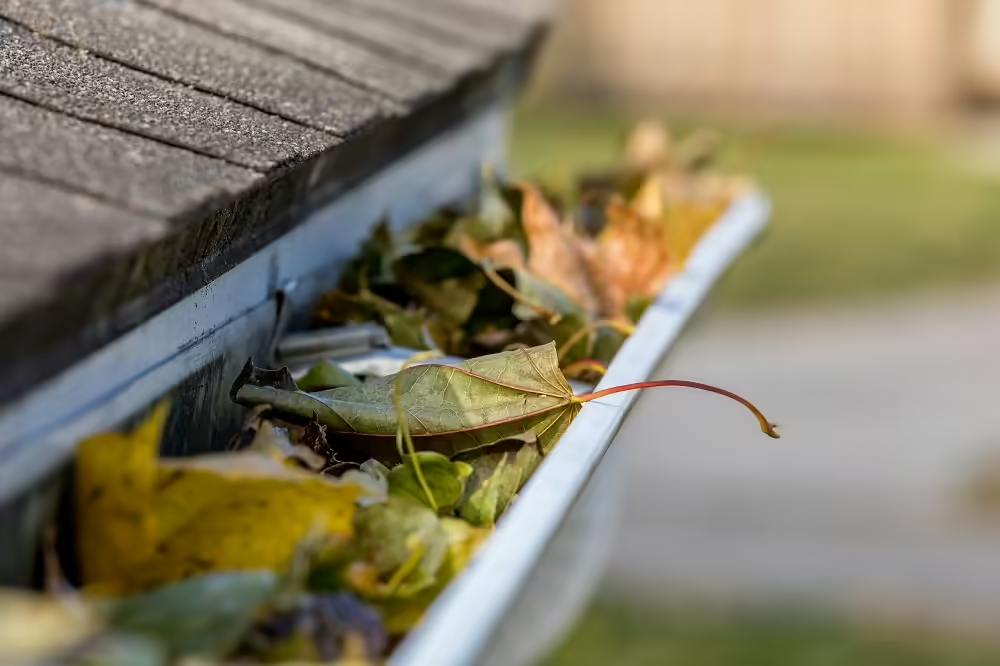When rainwater is not effectively channeled away from your home’s foundation, it can lead to many problems, including basement flooding, erosion, and structural damage.
Here we will discuss the primary causes of gutter overflow, such as clogs, improper installation, and insufficient capacity. Additionally, we will provide practical prevention tips to safeguard your home from the detrimental effects of water buildup. By understanding these factors and taking proactive steps, you can protect your property and avoid costly repairs down the line.
Common Causes of Gutter Overflow
Here are three common causes of gutter overflow:
Insufficient Gutter Capacity
Insufficient gutter capacity is a common cause of gutter overflow. Gutters that are too small or lacking enough downspouts cannot effectively handle heavy rainfall, resulting in water spilling over the gutter edges. This can lead to various problems, including foundation damage, erosion, and basement flooding.
Improperly Installed Gutters
Improper gutter installation can contribute significantly to overflow issues. If gutters are not pitched at the correct angle, water can pool instead of flowing smoothly towards the downspouts. This pooling can lead to clogs and overflows. Additionally, gutters that are not securely fastened to the fascia board can become loose over time, causing sagging and misalignment. These factors combined can hinder the gutters’ ability to effectively channel rainwater away from the house, resulting in overflow and potential water damage.
Blockage from Debris
Debris buildup is a common cause of gutter clogs. Leaves, twigs, and other organic matter can accumulate in gutters, obstructing the flow of water. This blockage prevents rainwater from draining properly, leading to overflow and potential water damage.
Damaged or Broken Gutters
Your gutters might not be overflowing but may be damaged. Cracks, holes, or missing sections allow rainwater to escape, potentially damaging your home’s exterior. Over time, damaged gutters can also become weakened, leading to sagging or detachment. This can worsen the issue and increase the risk of overflow. Regular inspections and prompt repairs are essential to prevent these problems and protect your home.
Gutter Overflow Solutions That’ll Help Protect Your Home
Addressing gutter overflow is crucial in protecting your home from water damage. Excessive rainwater overflowing from your gutters can lead to foundation damage, basement flooding, and even structural instability. Here are some effective gutter overflow solutions to prevent gutter overflow and safeguard your home:
One primary cause of gutter overflow is debris buildup in the gutters and downspouts. Regularly clearing out leaves, twigs, and other debris from your gutters and downspouts is essential to ensure proper water flow and avoid overflow. Also, trimming trees near your home will reduce the amount of debris, like leaves and twigs, that fall into your gutters.
Another crucial factor is the slope of your gutters. Gutters should be installed with a slight slope to allow water to flow towards the downspouts. Checking and adjusting the slope as necessary can help prevent gutter overflow.
Gutter overflow diverters are also effective in managing excess rainwater. These devices are installed at strategic points along the gutter system to redirect water away from vulnerable areas, such as the foundation, providing an extra layer of protection for your home.
In some cases, damaged gutters may be the root cause of overflow issues. Cracks, holes, or loose joints can disrupt the proper flow of water, leading to overflow. Repairing or replacing damaged gutters is essential to ensure the functionality of your gutter system and prevent overflow.
Effects of Gutter Overflow
Gutter overflow can have several detrimental effects on your home. Here are some common problems that can arise due to gutter overflow:
1. Foundation Damage and Basement Flooding: Accumulated water around the foundation can seep in, leading to cracks, shifting, and basement flooding. Over time, this can compromise your home’s structural integrity.
2. Roof and Siding Damage: Overflowing gutters can cause water to spill onto the roof and siding, leading to rotting, warping, and deterioration, which can be costly to repair.
3. Increased Risk of Mold and Mildew: Excess moisture from gutter overflow creates an environment conducive to mold and mildew growth. Mold can spread quickly and impact indoor air quality, leading to respiratory issues and allergies, as well as damage to walls, ceilings, and other surfaces.
Regular gutter cleaning and maintenance help ensure water flows freely through the gutters and downspouts, preventing overflow. Installing gutter guards can also help keep debris out, reducing the risk of clogs and overflow.
Preventative Maintenance Tips
Regular gutter cleaning and maintenance is essential to prevent gutter overflow. Clogged gutters can cause water to overflow and damage your home’s foundation, walls, and landscaping. Establishing a routine for gutter maintenance can help avoid these costly issues.
Inspect your gutters regularly, especially during the fall and spring when leaves and debris are more likely to accumulate. Remove any visible debris by hand or use a small garden trowel to scoop it out. For heavily clogged gutters, consider using a pressure washer or hose with a high-pressure nozzle to clear out the blockages.
Installing gutter guards or screens can also help prevent gutter overflow. These devices allow water to flow into the gutters while keeping out leaves and other debris. Gutter guards come in several types, including mesh screens, foam inserts, and solid covers. Choose one that suits your needs and budget, ensuring it is compatible with your gutter system.
Proper downspout placement is another critical aspect of gutter maintenance. Downspouts should extend at least 5 feet away from the foundation and direct water towards a sloped area or a designated drainage system. This helps prevent water from accumulating around the foundation, which can lead to leaks and structural damage.
FAQs: Gutter Overflow
Here are some frequent questions about gutter overflow:
How to fix gutters overflowing into eaves?
If your gutters are overflowing into the eaves, it is important to address the issue promptly to prevent further damage. Remove any debris, leaves, or blockages that might be causing the overflow. Ensure that the downspouts are clear and properly connected to the gutter system. Examine the gutters for any leaks or holes that may be contributing to the overflow. Repair or replace any damaged sections. Installing gutter guards can help prevent debris buildup and minimize the risk of overflow.
Is it normal for gutters to overflow in heavy rain?
In heavy rain, some degree of gutter overflow can be expected. However, excessive overflow or water pouring over the sides of the gutters may indicate an underlying issue. Ensure your gutters are properly sized and maintained to handle heavy rainfall.
Why is my gutter overflowing at the corner?
Obstructions and improper design can lead to corner overflow. Debris or clogs in downspouts can hinder water flow, causing it to back up and spill over at the gutter corners. Additionally, gutters without sufficient slope may allow water to pool and overflow at these points. Incorrect installation, such as improper positioning or inadequate support, can also contribute to corner overflow issues.
Contact DaBella Today for Your Gutter Replacement Project
Are you tired of dealing with gutter overflow? DaBella is here to help. We specialize in providing top-quality gutter systems that will effectively prevent overflow and protect your home from water damage.
One of the key components of our gutter replacement system is our K-style gutters. These gutters are designed with a unique shape that allows them to hold a larger volume of water compared to traditional gutters. This means they are less likely to overflow, even during heavy rainstorms. Our K-style gutters are made from durable materials, ensuring they can withstand the elements and provide long-lasting protection for your home.
In addition to our high-quality gutters, we also offer gutter covers to further enhance the performance of your gutter system. Our gutter covers are designed to keep leaves, debris, and other unwanted materials out of your gutters, preventing clogs and reducing the risk of overflow. With our gutter covers, you can say goodbye to the hassle of constantly cleaning out your gutters.
When it comes to your gutter replacement and installation, we have a team of trained installers who are experienced in replacing gutters efficiently and effectively. They will ensure that your new gutter system is installed correctly, providing optimal performance and protection for your home.
Contact us today at 844-DaBella for a free quote on your upgraded gutter system by DaBella. Our team will assess your gutter replacement needs and provide you with a personalized solution that fits your budget and preferences.

